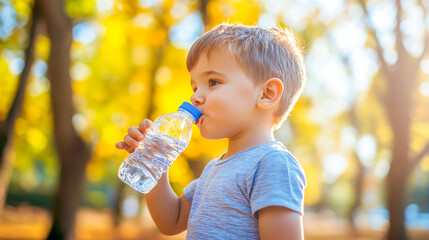The Importance of Hydration for Your Child
Dehydration in children is a significant risk year-round, especially for active kids. Children are at a higher risk of dehydration compared to adults due to their higher surface-to-mass ratio and faster metabolic rates. In simpler terms, because children are more active and have more body surface relative to their weight, they are more prone to fluid loss. Additionally, children may struggle to communicate thirst needs and rely on adults to provide drinks.
Why is water important?
Our bodies are made up of about 60% water, and it supports many vital functions, including:
-
Regulating temperature
-
Lubricating joints
-
Aiding digestion
-
Eliminating toxins and waste
-
Supporting skin health
-
Managing weight
-
Boosting energy levels
For children, staying hydrated also improves mood, memory, language, and concentration—key skills for learning and development.
How much water do kids need?
Water needs vary based on age, activity level, and climate, especially in dry, hot areas like Arizona. General recommendations:
-
Adults: Half your body weight in ounces (150 lbs = ~75 oz or 9–10 cups/day)
-
Birth to 6 months: Breastmilk or formula only
-
6 months: Introduce ½–1 cup of water daily
-
1–3 years: 4 cups/day including water and milk
-
4–8 years: 5 cups/day
-
8+ years: 7–8 cups/day depending on activity and environment
Signs of dehydration in children
Children can lose up to 1 quart of fluid per hour while playing or exercising outdoors, particularly in warm climates. They often don’t want to stop having fun to drink water, so it’s important to encourage water before, during, and after physical activity. The best strategy is to start hydrating days before intense activity.
Watch for signs of dehydration:
-
Dry mouth and lips
-
Headache or dizziness
-
Sluggishness or clumsiness
-
Excessive tiredness
-
Muscle cramps
-
Irritability
-
Flushed skin
-
Dark urine or fewer wet diapers (6–8/day typical for infants)
-
No tears when crying (in infants)
How to help your child stay hydrated
-
Be a good role model—drink water yourself
-
Carry water bottles and encourage your child to have their own
-
Set reminders on your phone or use a child-friendly reminder watch
-
Flavor water with lemon, lime, mint, cucumber, or berries
-
Make water part of a routine—drink before meals, school, or snacks
-
Encourage water drinking at school
-
Offer water-rich foods like cucumber, celery, tomato, lettuce, zucchini
-
Provide fruits high in water content: watermelon, strawberries, cantaloupe, blueberries, grapefruit
-
Freeze fruit in ice cubes to make water more fun
-
Make homemade fruit popsicles for hydration and cooling down
-
Let your child choose a special cup or bottle
Drinks to limit or avoid
-
Sugary drinks that replace the habit of drinking water
-
Juice blends or even 100% juice (whole fruit is better)
-
Flavored milk, which is often high in sugar
-
Artificially sweetened drinks, including Stevia—these are not well understood in children and may pose health risks
Final thoughts
Drinking more water supports a healthy, active lifestyle. It’s affordable, contains no calories or added sugar, and plays a key role in helping your child play better, function better, feel better, and live better.
References
-
Kristen E. D’Anci, et al. Hydration and Cognitive Function in Children, Nutrition Reviews. https://doi.org/10.1111/j.1753-4887.2006.tb00176.x
-
Bailey, W. MD. (2024). How to Stay Hydrated in the Heat. www.villagemedical.com
-
Bhavsar, D. et al. Child Dehydration Management: A Health Literacy-Focused Resource Analysis, American Journal of Health Education. https://doi.org/10.1080/19325037.2021.1973618
-
Rethy, J. MD. (2024). Choose Water for Healthy Hydration. www.healthychildren.org







